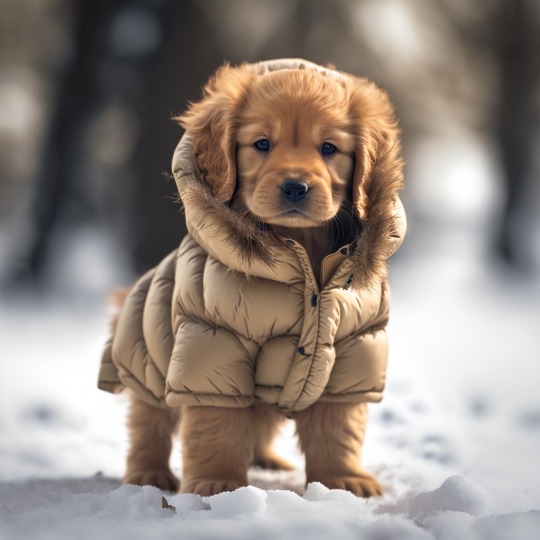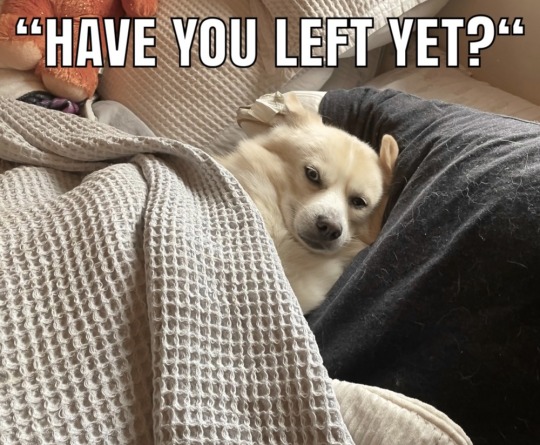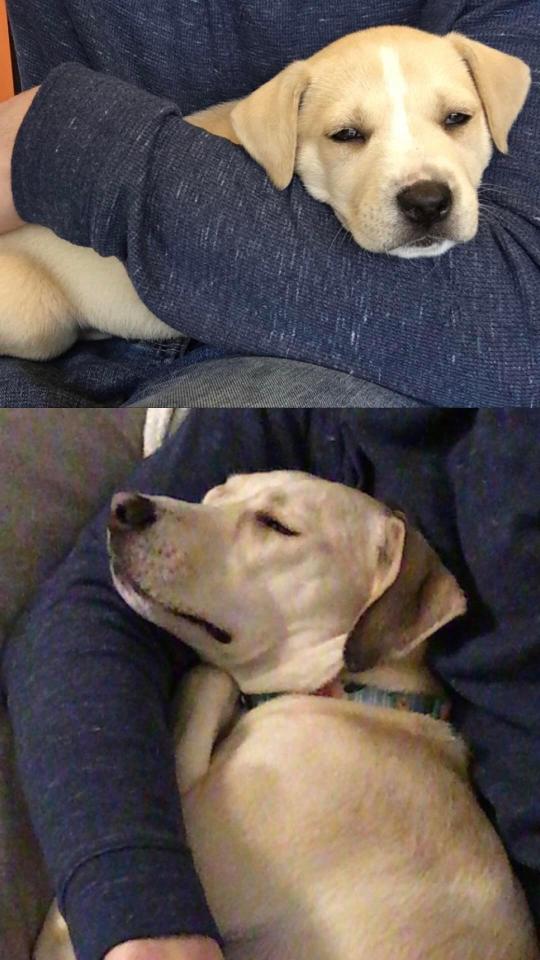#dog behavior
Text
If dog buttons have one hater I am that very hater.
Communicating “in the same language for the first time” through dog buttons as Christina Hunger describes in her book is a failure of the most human proportion, putting too much value on the human (English) spoken word and ignoring that every detail, movement, twitch of our dogs is an act of communication itself. They are already communicating with us, just as human and primitive dog first did thousands of years ago. Just how we have shaped each other’s evolution by our very relationship. The dog understands you without buttons. If you can’t understand a dog without buttons, or “speak the same language” without human spoken language that is your HUMAN failure.
#dogblr#dog behavior#dog buttons#sorry but that passage really pissed me off#dogs and humans are forever inter connected#a button is unnecessary#emphasis on the spoken word as the ‘one true way’ is unnecessary
5K notes
·
View notes
Note
Do you know why dogs do that little exhausted sigh when they lie down even when they haven't really done anything that particular day?
I, too, make exhausted little sighs when I flop down and am suddenly extremely comfy!
But, okay, here's what super interesting. I didn't want to just give you a flippant answer, so I started looking up if sighing is a behavior in other species than humans. Because it's always worth keeping an eye out for accidental anthropomorphism. Turns out? The science on sighing is fascinating. Stay tuned for intense nerding out, and maybe a bit more of an answer.
First off, we gotta know what a sigh is.
"The sigh is a deep augmented breath with distinct neurobiological, physiological, and psychological properties that distinguish it from a normal eupneic breath. Sighs are typically triggered by a normal eupneic breath and are followed by a respiratory pause, which is referred to as 'postsigh apnea.'"
In non-jargon, that definition means sighs are a deep breath with a different pattern to it than normal, easy, regular breathing. "Augmented breaths" are frequently used as a synonym for "sighs", and the best definition I found is that "they comprise prolonged inspiration and increased tidal volume followed by a respiratory pause and several seconds of faster breathing. So a longer than normal inhale where you take in more air than normal, then an exhale, and then pause before breathing in again. Oh hey, look, I found a graph!

The graph is super well labeled, but just to be clear: each cycle of the red line is a normal breath, where what's being tracked is the movement of the chest wall. The part where the vertical blue bar is, that's the cycle with a sigh. The red line spikes really high (during inspiration, or breathing in) at that blue patch, and for longer than the normal period of a breath. See how it's almost like two inhales on top of each other - a normal slope and then another upward spike? That's the "augmentation" of the normal breath, almost a double inhale without breathing out in-between. Then, after the red line drops (on the exhale) there's a flat bit. That's the respiratory pause, which the period after the sigh where you wait before you inhale again.
Apparently people have been tracking sighing scientific for like, over 100 years. The first record of it in academic literature was in 1919. And we know some really cool stuff. All humans sigh spontaneously. Even babies sigh! They do it every few minutes, whereas it's less frequent but still pretty regular in adults: one study found about once every five minutes, or twelve sighs an hour.
Okay, but why do we sigh? We only sort of know, because there's a bunch of different things that have to be studied to answer that question. The direct physiological aspect of it is the most well known at this point. You've got lots of little sacs lining your lungs, called alveoli, that facilitate gas transfer from the air you breathe into your blood. They make sure oxygen goes in and carbon dioxide gets breathed out. But sometimes they collapse and deflate, which prevents them from doing their job. When you do a big sigh, the air quantity in your lungs ends up being double that of normal, which inflates them again. So sighing is a way of doing lung maintenance, in a sense.
But there's so much more going on when you sigh than just that! This is the stuff researchers are still working on. They've got some pretty solid conclusions to start, but they're very emphatic that there's a ton more to learn.
Basically, the main hypothesis right now is that sighing functions as a "reset" for your internal state when it's out of balance. People sigh more when they're acutely anxious or stressed, are anticipating a negative outcome like a shock or seeing a negative image, or have chronic anxiety, PTSD, or panic disorders. Higher sigh frequency is also associated with pain: people with chronic low back pain sigh more, and how much they do correlates with how high their pain rating is at the time!
Another aspect of sighing is that it's frequently associated with periods of relief. Studies have noted that people sigh when they're able to relax following tension, like if they're interrupted while trying to do something really mentally taxing, when they finish a task that took a lot of attention for a long time, or if a negative stimulus stops/goes away. The reason behind that is actually thought to be why people sigh so much when they're upset or in pain: sighing doesn't just signal relief, but actually cause it! Some studies have found that people experience a temporary reduction in muscle tension right after a spontaneous sigh. (Unfortunately, that doesn't seem to also happen when you sigh on purpose.)
Sighing is also thought to facilitate behavioral and emotional transitions. The frequency at which someone sighs changes even just when they transition from sitting to lying down. People frequently sigh right before they fall asleep or start to wake up. One study found that people sigh more frequently when they go from a situation of being unable to anticipate what's next to a situation where they know what the outcome will be - regardless of if that outcome is going to be negative or positive! That led the researchers to hypothesize that sighing functions as an emotional reset from states of high internal arousal (a word which here means "the state of feeling awake, activated, and highly reactive to stimuli.") So sighing might not just bring relief when something really intense ends, but it might also help people prepare for upcoming stress.
Basically, researchers think that sighing may contribute to what they call "psychophysiological flexibility." That means that sighing helps keep someone in a physiological and emotional state that matches the situation they're in, and helps the body and mind adapt quickly when something changes. They noted that these types of transitions may involve "anticipatory, activation or recovery responses." In other words: they think spontaneous sighing is relevant not only when you're worried about encountering a leopard in the bush, but when you have to hide from the leopard you tripped over, and then also when you're calming down after the leopard got bored and left.
There's a whole bunch of research left to do about how exactly spontaneous sighs do what they do, but there's also a whole other aspect of the behavior that hasn't really been studied yet: their social function! In humans audible sighing is a salient social signal. (The researchers said the part of the paper addressing this that it is a "lay belief" that sighs have a "communicative function to convey emotions," which makes the whole thing feel like it was written by aliens observing humans from afar). But they did note that sighs for social communications may be totally different from other types of sighs, since the exhalation is often very exaggerated and doesn't always occur in tandem with that "augmented" inhale pattern that spontaneous sighs have.
Okay. So. I've been a nerd forever, but what about doggo sighs? Why do they occur? Obviously, the research doesn't give us a direct answer. The majority of the behavioral / situational research on sighing has been done on people, not animals. But it's pretty well documented lots of animals sigh (it might even be all mammals, I just don't have a citation for that). And some of the studies that have been done on animals indicated that they, too, sigh in relief when negative situations end or unpleasant stimuli go away.
Let's go back to my joke at the beginning of this book I've written. My first instinct was to be like "who doesn't sigh in relaxation when they finally get a chance to rest their bones?" That totally matches what's in the research: getting a chance to rest after activity is often both a behavioral transition and an emotional one, and if there's any physical discomfort being experienced, physical rest is often is a relief.
It seems fairly probable that dogs sigh when they lay down for at least one of those reasons. I can't prove that hypothesis, but it tracks with what the science says so far. The situation you described meets the main identified criteria for sighing: there's the physical transition of laying down, the behavioral/emotional transition of being ready for a period of low/no activity, and the possible relief of pain or discomfort that comes with laying down. We don't have any any evidence (that I was able to find) of species that sigh for other reasons, or sigh in situations that don't meet those criteria. We don't know for sure that this is accurate - this isn't fact, simply my educated guess. But since sighing seems to help muscles relax and relief discomfort, it seems reasonable to me that a good old sigh after the relief of laying down would make the transition to a resting state feel even better.
Sources:
Effects of the hippocampus on the motor expression of augmented breaths
Brainstem activity, apnea, and death during seizures induced by intrahippocampal kainic acid in anaesthetized rats
The Integrative Role of the Sigh in Psychology, Physiology, Pathology, and Neurobiology
Sigh rate during emotional transitions: More evidence for a sigh of relief
The psychophysiology of the sigh: I: The sigh from the physiological perspective
The psychophysiology of the sigh: II: The sigh from the psychological perspective
Affect Arousal
UCLA and Stanford researchers pinpoint origin of sighing reflex in the brain
#science!#dog behavior#sighing#sighs#I want to emphasize this is a hypothesis based on the existing body of research and that I am not an expert in this field#there are times where it is reasonable to look at the existing literature and create theories based on a synthesis of their findings#but this is not something to repeat as known fact#and that differentiation is extremely important in this sort of forum
3K notes
·
View notes
Text

#dog#doggo#dogtraining#cute dog#dogsofinstagram#funny dog#funny dogs#my dog#dog behavior#dogblr#cachorro#cachorrinhos#puppy
367 notes
·
View notes
Text
Does anyone have any good resources on dog-dog resource guarding in multi-dog households?
I'm looking for force free resources of any kind, so videos, podcasts, books, blogs, whatever, as long as it's sensible and useful.
Please, and thank you!!!
Navi has always been a typical little herding dog who takes it upon herself to "enforce rules" and it was usually not problematic at all, it was moreso a quirk. However, she's tried to guard her bowl and a cardboard box (love that for her) in front of Maisie and a friend's dog in the past month. I'm pretty convinced this is linked to her being in heat, since it's been a tough one for her, but I think we'd benefit from working on this regardless. Don't want it to escalate and create conflict with other dogs and I also don't want her to feel unsafe with her food etc.
I already do a lot of things to manage it, and I know how to work on resource guarding between dogs and people, but I honestly don't have that many resources on dog-dog resource guarding and how to effectively manage or solve it.
#dogblr#dog behavior#resource guarding#dog training#lol resources on resource guarding#please don't resource guard your resources on resource guarding!#if you unfollow after reading this I will understand
64 notes
·
View notes
Text
being able to shake all the water off of me after a shower like a dog would fix me
59 notes
·
View notes
Text
blatantly stolen from the Working Australian Cattle Dog Group:
For fun, and to share opinions.
What's your definition of a biddable dog?
What about an independent dog or independent thinker?
Can those two things be synonymous or do you have one or the other?
#dogblr#dog behavior#thinking about what various parameters of dog behavior look like#and how to communicate better with other people#will get to my own answer in a bit#ironically if I take any longer to get my ass downstairs my cattle dog is going to pitch a fit at me
42 notes
·
View notes
Text
Dog buttons upholding Proper Verbal Communication as the one and only true valid form of communication with humans is the bane of my autistic, poor auditory processing, tonally flat, occasionally nonverbal existence. And as the parent of an ADHD kid whose primary mode of communication is not spoken words.
If my fiance can tell I'm happy because I'm flapping my hands, and I can tell what my kid is saying with a gesture and squeak, then you too can learn that your dog staring deep into your eyes and then walking towards something is clear communication of "I want a thing"
230 notes
·
View notes
Text

This is how you show someone you love them, right?
#my art stuff#digital art#sketch#doodle#comic#astarion#astarion ancunin#raphael#tav#durge#tiefling tav#tiefling durge#mouse#(it’s alive)#astarion x tav#astarion x durge#raphael x tav#raphael x durge#astarion x raphael#dog behavior#bones#bone pile#pile of bones#raphael being a frustrated dog dad#astarion being an experienced dog dad#I spent the entirety of act one putting different bones in astarion’s inventory#it did nothing about his approval rate but it made me happy#so he can suck and egg 🧡🧡😤🧡🧡
23 notes
·
View notes
Text
Watching tv shows when any dog appears has been ruined for me bc I just start searching for “I am being good dog looking at my cue and waiting for my high value reward!” face and it’s very distracting lmao.
462 notes
·
View notes
Note
When I treat my dog for something, sometimes he seems to play with his treat? He goes into play bow and sorta bats at the treat with his paws then throws it in the air and chases it before he eats it? Why?
Sounds like he's having fun! Think about what toy play looks like - it's pretty similar behaviors, much of the time. If treats are super exciting, maybe it's more enjoyable to play with it before eating it and ending the fun time.
153 notes
·
View notes
Text

159 notes
·
View notes
Text

#my meme#my memes#white dog#dogs#my dog#dog memes#dog meme#dog guy#dog girl#dog humor#dog behavior#cute doggo#doggo#funny dogs#huskies#siberian husky#pomsky#fluffy dog#sleepy doggo#sleepy dog#puppy#my puppy#puppies#husky puppy#puppy dog#dogblr#fluffy puppy#dog care#dog content#original meme
21 notes
·
View notes
Text
From feral mongrel to PhD in 2 weeks
#chi#chihuahua#dogblr#chocolate#cute animals#cute dog#dog#pets#rescue#smol#dog training#dog behavior
20 notes
·
View notes
Text

Dogboy clown ‼️
#digital art#furry art#artwork#artists on tumblr#oc artist#oc artwork#furry character#furry community#sfw art#humanoid#clown oc#clowncore#dogboy#dog behavior#gay#⭑my art
11 notes
·
View notes
Text
wish i had a tail bc wiggling my body is NOT ENOUGH
25 notes
·
View notes
Photo

My puppy Ella. From a 6 week old to a 1.5 year old. Still loves to cuddle the same way, and yes, that’s the same shirt via
Submitted March 27, 2020 at 08:21AM by i-Midget, Poop4U
#meme#funny#pet#pets#poop4u#doglover#cute dog#doggrooming#dogs of tumblr#dogmeme#my doggo#puppy doggo#dogblr#dogtraining#best doggo#doggoargentino#cute doggo#dog behavior#dogood#dogsofinstaworld#dogstagram#dogoftheday#puppy#puppylife#puppy pictures#puppygram#puppy picture#dog#dogs#doggo
71 notes
·
View notes